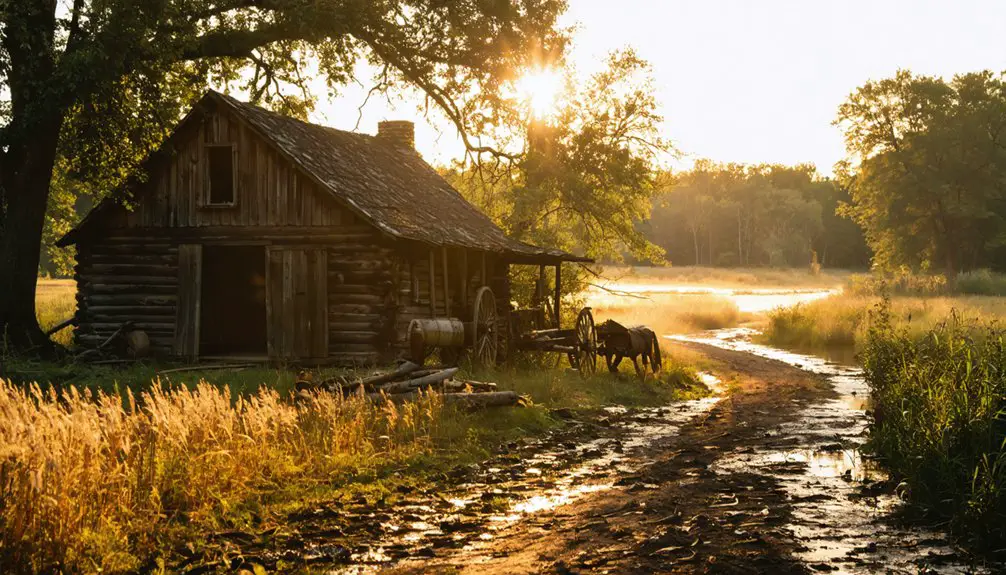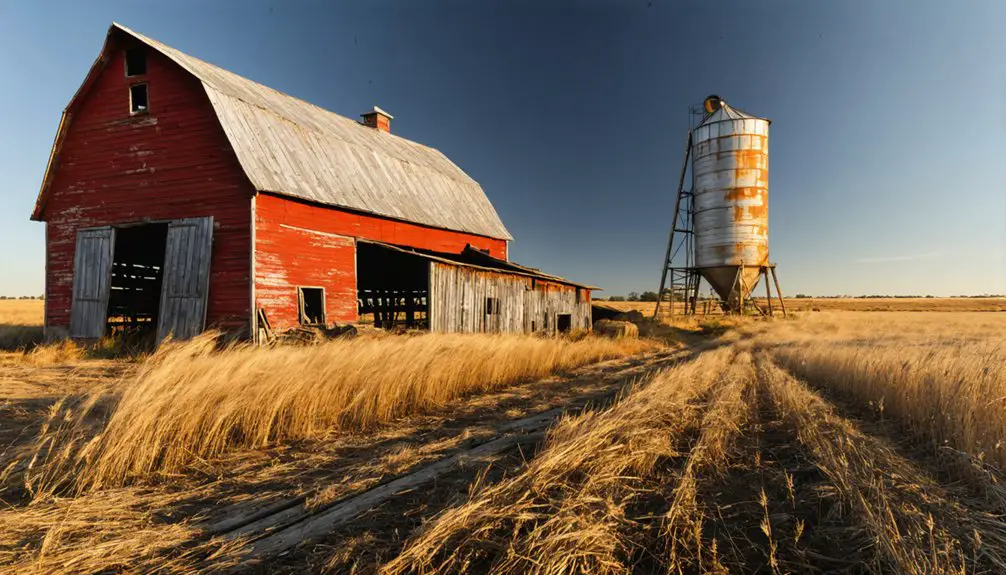You’ll find Leaf River’s ghost town legacy in central Minnesota, where it once thrived as a bustling railway hub during the 1880s. The Great Northern Railway transformed this former Native American settlement into an essential trading center, with monthly railway payrolls exceeding $60,000. Today, only about 50 residents remain, but you can still explore the historic schoolhouse, town hall, and modern amenities like the local restaurant and golf course. The story of this town’s rise and fall holds fascinating secrets in its quiet streets.
Key Takeaways
- Leaf River transformed from a bustling railway trading hub in the 1880s to a ghost town with approximately 50 current residents.
- The community’s decline began after its post office closed in 1908, marking the end of its commercial golden era.
- Historic structures, including the old town hall and schoolhouse, remain as physical remnants of the town’s prosperous past.
- The Great Northern Railway’s presence once made Leaf River a significant commercial center with monthly payrolls exceeding $60,000.
- Modern amenities include a restaurant and golf course, though the town retains its ghost town character from its trading hub past.
Early Settlement and Native Origins
Long before Leaf River became a ghost town, the area teemed with Native American life and culture, particularly among the Dakota and Ojibwa peoples who called this region home for thousands of years.
You’ll find evidence of their early settlements dating back to 11,000 B.C., with burial mounds and dwelling sites scattered throughout the landscape.
The Wahpekute, known as “The Shooters Among the Leaves,” lived off the land’s abundance, making their homes near lakes where they’d fish, hunt, and farm.
Native American traditions centered around wild rice harvesting and small game hunting flourished here.
However, tensions grew as the Ojibwa pushed the Dakota southward in the late 1700s, forever changing the region’s tribal makeup and setting the stage for future conflicts. The need for safer trade routes emerged after an attack on a Dakota hunting party led to the creation of the Woods Trail system.
The Rise of the Railway Era
You’ll find the Great Northern Railway‘s arrival transformed Leaf River from a quiet settlement into a bustling trading hub, where local farmers enthusiastically brought their grain and produce to market.
The rail station quickly became the heart of commerce, drawing merchants and traders who’d set up shops to serve both local residents and travelers passing through. Much like the thriving city of Burlington in Vermont, the town became an important regional center.
If you’d visited during this golden age of rail, you would’ve seen freight cars loaded with agricultural goods departing daily, while incoming trains brought manufactured goods and supplies that sustained the growing community. The station generated significant economic activity, with monthly payrolls exceeding $60,000 for railway workers who maintained and operated the vital transportation link.
Great Northern’s Economic Impact
During the late 19th century, the Great Northern Railway emerged as a powerful force that transformed Minnesota’s economic landscape.
You’ll find that this railway expansion wasn’t just about laying tracks – it revolutionized how Minnesotans conducted business and lived their daily lives. The railroad’s influence led to remarkable economic diversification, connecting farmers, miners, and loggers to distant markets while slashing transportation costs.
You can trace the railway’s impact through the countless jobs it created, from track workers to depot managers. Local businesses flourished as the Great Northern’s network grew, and new towns sprouted along its routes. Just as modern rail services like NLX aim to deliver more economic returns to communities than their construction costs, the Great Northern Railway propelled local economies forward.
The railroad’s efficient freight rates meant your great-grandparents could ship their grain or timber at competitive prices, while immigrants found new opportunities in the bustling communities that developed around the rail lines.
Rail Station Trading Hub
The Great Northern Railway’s expansion shaped more than just Minnesota’s economy – it transformed Leaf River into a bustling rail station trading hub.
You’d have found yourself at the center of regional trade networks as railway logistics connected local farmers and merchants to markets across the Midwest and beyond.
- Steam locomotives thundering across the Leaf River Bridge, carrying grain, timber, and supplies
- Busy loading docks where workers hefted crates and barrels onto freight cars
- Merchants gathering at the station platform to receive their latest shipments
- Horse-drawn wagons lined up to deliver farm products for rail transport
Multiple internal links helped travelers and merchants navigate between Leaf River’s various railway facilities and trading posts.
If you’d visited between 1880-1908, you’d have witnessed the station’s golden era, when two separate runs of postal service marked Leaf River’s peak as a crucial transportation link in Minnesota’s growing rail commerce.
Similar to the historic Bensenville Yard operations, Leaf River served as a vital connection point for regional freight movement.
Post Office and Commercial Growth
As Leaf River emerged as a frontier settlement, its commercial growth became intrinsically linked to two essential institutions: the post office and the Great Northern Railway station.
You’ll find that the post office’s significance was evident in its two operational periods: 1880-1882 and 1902-1908, serving as a crucial hub for communication and commerce in this developing community.
Building upon the area’s rich trading heritage, which included Reaume’s 1792 fur-trading post and the American Fur Company’s 1830 operation, the railway station and post office created a powerful commercial hub.
The establishment of Northern Pacific Railroad through the southern portion of the township further strengthened transportation connections in the region.
These institutions connected you to broader trade networks and critical services. However, the post office’s eventual closure in 1908 marked a turning point, signaling the beginning of commercial decline that would ultimately lead to Leaf River’s ghost town status.
Indigenous Heritage and Cultural Impact
Long before European settlers arrived, rich indigenous cultures thrived along Leaf River’s banks, where you’ll find evidence of both Dakota (Sioux) and Ojibwa (Chippewa) peoples who called this land home.
Their indigenous traditions shaped every aspect of life along these waters, demonstrating remarkable cultural resilience through seasonal adaptations and resourceful living.
- Burial mounds dot the landscape, telling stories of the ancient Mound Builders who lived here as far back as 11,000 B.C.
- The Wahpekute Dakota, known as “Leaf Shooters,” built winter lodges from bison hides.
- Summer brought changes to elm bark homes near prime fishing spots.
- Wild rice harvesting and hunting sustained communities until European fur traders arrived.
These rich traditions faced disruption through conflict and forced displacement, though their legacy endures in the land’s very name.
Economic Transformation and Decline

Once bustling with logging operations and farmland prosperity, Leaf River’s economic story traces a dramatic arc from thriving industry to ghost town status.
You’ll find the town’s transformation rooted in its dependence on the Great Northern Railway, which initially fueled its success but later contributed to its decline when major rail routes shifted elsewhere.
As logging operations moved to other regions and farming mechanization took hold, Leaf River’s economic sustainability crumbled. Like many Minnesota ghost towns affected by the Panic of 1857, economic pressures forced residents to seek opportunities elsewhere.
The remaining town hall stands as one of the few surviving structures from the original settlement, serving as a silent witness to the community’s past.
Population shifts followed quickly – from a vibrant community to today’s mere 50 residents.
You can still glimpse remnants of the town’s prosperous past in the old town hall and schoolhouse, while modern amenities are limited to a restaurant and golf course.
What was once a thriving industrial hub has evolved into a quiet reflection of changing times.
Geographic Location and Natural Features
When you explore Leaf River’s geography in central Minnesota, you’ll discover a landscape sculpted by ancient glaciers in Wadena County’s Leaf River Township.
Located at 46°29′19″N latitude and 95°04′54″W longitude, this ghost town’s geographic characteristics reveal a rich tapestry of natural resources shaped by ice age deposits. The area exhibits conical hills and depressions characteristic of the region’s morainic topography.
- Rolling morainic ridges create an undulating terrain with distinctive egg-shaped hills
- Mixed forests of pine and deciduous trees blanket the glacial outwash plains
- The namesake Leaf River winds through the township, joined by the meandering Otter Tail River
- Numerous lakes dot the landscape, including Pine, Little Pine, and Marion, creating diverse wetland habitats
You’ll find yourself surrounded by the Leaf Mountains, so named by the Ojibwa for their rustling, leaf-covered slopes that define this remarkable region.
Historical Trade Routes and Fur Trading

As the early fur trade flourished in central Minnesota during the late 18th century, Leaf River emerged as a significant hub connecting Lake Superior to the Red River settlements.
You’ll find the remains of Joseph Réaume‘s 1792 trading post where the Leaf and Crow Wing Rivers meet – a strategic location that shaped the region’s fur trade dynamics for decades.
The waterways you’d travel back then formed essential arteries for traders, trappers, and missionaries moving between eastern and western territories.
Indigenous relations, particularly with local Ojibwe communities, proved important to the post’s success. Here, European goods exchanged hands for valuable furs, while traders like Réaume worked as interpreters and negotiators.
Though fire later destroyed the original post, the American Fur Company established another around 1830, cementing Leaf River’s commercial importance.
Modern Day Remnants and Activities
Today’s visitors to Leaf River will find a fascinating blend of preserved history and modern life among the remaining structures.
While the population has dwindled to about 50 residents, you’ll discover an active community that maintains its rural character through current community activities and recreational tourism opportunities.
- You can explore the historic old schoolhouse and town hall, which stand as silent sentinels to the area’s past.
- You’ll find a welcoming restaurant serving locals and travelers alike.
- There’s a golf course that draws visitors while preserving the town’s peaceful atmosphere.
- You’re free to wander among partially abandoned buildings, though you’ll need to exercise caution due to their fragile state.
The area offers a unique experience where you can step back in time while enjoying modern amenities in a sparsely populated setting.
Legacy Among Minnesota Ghost Towns

Situated among Minnesota’s numerous ghost towns, Leaf River stands out for its distinctive blend of indigenous heritage and railroad-era development.
You’ll find its story deeply intertwined with the social dynamics that shaped many of Minnesota’s lost communities, from the Ojibwa influence reflected in its name to the rise and fall of railroad prosperity.
Like other ghost towns across the state, Leaf River’s fate was sealed by environmental influences and shifting transportation patterns.
When the railroad’s importance waned, the town’s liveliness diminished.
Yet what sets Leaf River apart is its rich cultural legacy, preserved in the *Gaaskibag-wajiwan* origins of its name and its connection to ancient trade routes.
Leaf River’s enduring legacy echoes through its Ojibwa name, *Gaaskibag-wajiwan*, marking centuries of indigenous presence along historic trading paths.
Today, it serves as a compelling example of how Minnesota’s ghost towns reflect both the promise and vulnerability of railroad-dependent communities.
Frequently Asked Questions
What Were the Major Natural Disasters That Affected Leaf River?
Like a relentless wave, flood events pummeled your Whitewater River Valley up to 20 times yearly in the 1920s, depositing 15-foot sediment walls. You’ll find no specific tornado occurrences documented here.
Are There Any Documented Paranormal Activities or Ghost Stories From Leaf River?
You won’t find documented ghost sightings or haunted locations in Leaf River’s records. While it’s called a ghost town, that’s due to population decline rather than any verified paranormal activity.
What Was the Highest Recorded Population of Leaf River?
Ever wonder about those lost historical demographics? You won’t find an exact peak documented, but based on population growth patterns and local records, it’s estimated to have reached several hundred during its lumber boom days.
Did Any Notable Historical Figures or Celebrities Ever Visit Leaf River?
While you’ll find Henry Rice and Ojibway leader Hole-in-the-Day visited the region near Leaf River, and fur traders like McGill passed through, there’s no record of famous visitors at notable events specifically in town.
What Specific Businesses or Industries Operated in Leaf River Besides the Railway?
You’d find a bustling timber industry with sawmills, two general stores, two hotels, and a post office. Local farms raised crops and livestock while serving the town’s hardworking residents.
References
- https://en.wikipedia.org/wiki/Leaf_River
- https://www.youtube.com/watch?v=5bCG6B2rzZY
- https://www.startribune.com/ghost-towns-minnesota-nininger-forestville-old-crow-wing/601169483
- https://quickcountry.com/minnesota-ghost-towns/
- https://ottertailcounty.gov/history/leaf-city/
- https://ottertailcounty.gov/history/
- https://oldwadenarendezvous.org/redriver/
- https://www.nps.gov/miss/learn/historyculture/river-of-history-chapter-2.htm
- https://www.ricecountymn.gov/DocumentCenter/View/2180/Historical-Settings–Resources-Early-History?bidId
- https://baldwinmn.gov/great-northern-railway/



